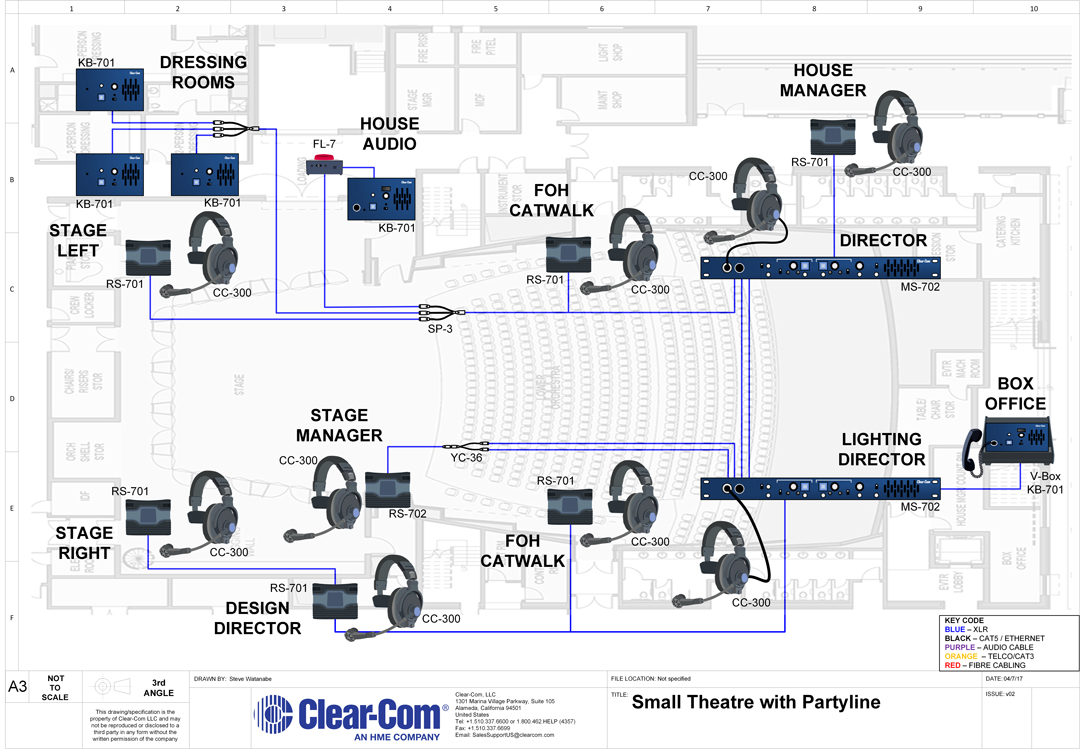
Intercom systems are an essential part of live event production, but they are often a misunderstood oddity of the audio production tool kit. Without intercom, the producer can’t call the show, the director can’t ask the camera op to pan left, and the FOH engineer can’t notify the monitor engineer that they’re switching over to the back-up mic.
Party-line intercom systems are the simplest form of this important solution for live event production communications. Although intercom is not strictly a live sound technology, it most typically falls into the wheelhouse of the audio provider/crew if the show doesn’t warrant a dedicated intercom technician.
In this article, we will discuss the basics of analog, two-wire party-line systems. Stay tuned for future articles where we will discuss matrix systems, wireless intercom solutions, and the many types of intercom accessories and interfaces.
First, let’s start with some important definitions:
- Party-line: Also known as a PL or conference line. When someone speaks, everyone can listen. The best example is a telephone conference call.
- Two-wire: A term meaning that talk and listen are on the same line. Electrically, there are only two wires needed to make this system work.
- Simplex: Communication where only one person can talk at a time. A good example is typical two-way radio communication; only one person can key the radio at a time.
- Full Duplex: Communication where everyone can talk and listen at the same time. Quite convenient in live event production, but can quickly devolve with many users on the same line.
- Headset: A headphone set with a microphone attached. This is the main way users communicate on intercom systems. It can have one headphone (single-muff) or two headphones (double-muff), and microphones can come in dynamic or condenser styles.
- Belt Pack: A portable user station. This can be clipped to a belt or gaff taped onto just about anything! A headset will plug into the belt pack for the user to talk/listen, and an external connection to the intercom system will power the unit. Often, the combination of a belt pack and headset is referred to as a “drop” of intercom.
- Main Station: A rack-mounted user station unit with the ability to intercommunicate with multiple channels (sometimes called a base station). Most of these have the ability to communicate with a headset or with a built-in speaker and gooseneck microphone.
- Master Station: A main station that also provides a power supply for the intercom system.
- Sidetone: A small amount of the microphone feedback to the headphone circuit. This allows the user to hear that they have correctly keyed a channel.
- Call: Allows user stations to generate and display a visual signal. This can be used to get someone’s attention or to cue a specific event.
- Wall Panel Station: User stations that can be mounted directly into walls. These typically have built-in speakers for easy communication with backstage areas like dressing rooms.
- Wet / Dry: A term used to denote whether a two-wire XLR line carries power on it (wet) or has been stripped of power to only include audio (dry).
Clear-Com and RTS Two-Wire Systems
While there are many brands of two-wire party-line systems, there are two major styles of wiring conformity that you are likely to see on a show-site: Clear-Com and RTS. Clear-Com style systems are used in many theatrical and rock-n-roll productions, while RTS style systems are used for AV and broadcast applications.
Both styles of two-wire party-line use standard microphone interconnect cable with 3-pin XLR connectors, but they are not natively compatible with each other. Clear-Com style systems have separate lines for power, audio, and ground conductors, and will only have a single channel of duplex party-line audio. RTS style systems have a conductor with power and audio, a conductor with just audio, and a ground, so they are able to squeeze two channels of duplex party-line audio on a 3-pin XLR connection. See the wiring diagram below.
Both of these systems rely on a distributed amplifier model. Within each user station is a tiny mixer circuit that brings in the external signal and adds the user’s microphone with a special echo cancellation circuit. Typical user station controls include a listening volume adjustment for the channel, a talk button, and a call button to signal other users. More advanced user stations allow for control of sidetone adjustment, and a control to set the action of the talk button to be latching (push to talk, then push again to disengage) or non-latching (talk only while the button is being pressed).
Because both of these systems use a distributed amplifier model, there is no directionality in the wiring connections. In fact, connections can be split with y-cables or adapted with XLR turnarounds without any loss to the intercom signal. This allows for simple scalability of two-wire systems for larger topologies. Here is an example of a small theatre party-line Clear-Com system that uses a combination of master stations, belt packs, and wall panel stations.
Limitations of Analog Party-Line Systems
Party-line systems are great for helping to coordinate a production team, but they do have their downsides. An inherent drawback of party-line is the lack of private communication. If the producer needs to have a conversation with a spot operator, it will tie up the line for any other communications. Additionally, there are length limitations for extremely long runs of XLR and having users being tethered to an XLR line can be difficult (for instance, a stage manager that might be moving around in a backstage wing).
Lastly, interconnecting between different brands of two-wire systems, between two-wire and matrix, or two-wire and wireless systems will always involve special kinds of interfaces, adapters, and a certain amount of black magic (we’ll dive into this more in future articles). While these limitations exist for wired, party-line systems, there are solutions that address the issues of private communication and mobility that we will talk about in future articles.
Conclusion
Intercom is an essential service of the live event industry. Two-wire party-line systems are an easy and simple solution for event production communications, and work especially well with smaller crews. They are fairly low-cost to purchase and relatively easy to integrate, and widely available as rental systems.
The limitations of two-wire wired systems related to complexity, private channels, and mobility have created an environment for matrix intercom, wireless systems, and intercom over digital transport that will be addressed in future articles in our demystifying series. Stay tuned!
For questions about designing a party-line intercom systems or a quote on two-wire system components, contact the Sales Team at sales@tcfurlong.com. For questions regarding intercom items in our rental stock, contact the Rental Team at rentals@tcfurlong.com.
For more technical tips, sign-up for our email newsletter!

